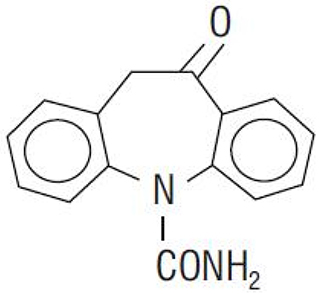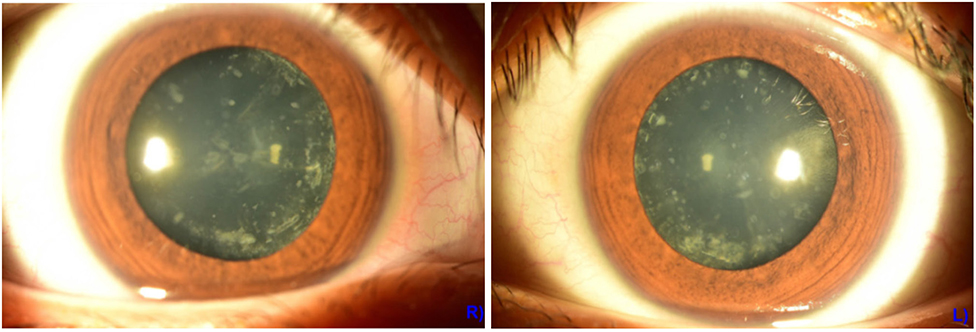J Korean Ophthalmol Soc.
2019 May;60(5):486-490. 10.3341/jkos.2019.60.5.486.
Bilateral Cataract after Taking Oxcarbazepine
- Affiliations
-
- 1Department of Ophthalmology, Samsung Medical Center, Sungkyunkwan University School of Medicine, Seoul, Korea. ldhlse@gmail.com
- 2Department of Preventive Medicine, Graduate School, The Catholic University of Korea, Seoul, Korea.
- KMID: 2445144
- DOI: http://doi.org/10.3341/jkos.2019.60.5.486
Abstract
- PURPOSE
To report a case of bilateral posterior subcapsular cataract after taking oxcarbazepine (Trileptal®, Novartis, Basel, Swiss).
CASE SUMMARY
A 19-year-old female visited our clinic with decreased vision in both eyes. Her best-corrected visual acuity was 0.3 in the right eye and 0.5 in the left eye, and slit-lamp examination revealed a bilateral cortical opacity and subcapsular cataract. She had been taking oxcarbazepine for epilepsy for 10 years, which was discontinued 3 years ago. Her mother had undergone cataract surgeries when she was approximately 46 years of age. No other risk factors for cataract were present.
CONCLUSIONS
In the present case, bilateral cortical opacity and subcapsular cataract were assumed to be associated with the use of oxcarbazepine. We suggest that oxcarbazepine could induce a cataract and recommend a regular follow-up by a qualified ophthalmologist.
MeSH Terms
Figure
Reference
-
1. Stables JP, Bialer M, Johannessen SI, et al. Progress report on new antiepileptic drugs. A summary of the Second Eilat Conference. Epilepsy Res. 1995; 22:235–246.
Article2. Tecoma ES. Oxcarbazepine. Epilepsia. 1999; 40:Suppl 5. S37–S46.
Article3. Bill PA, Vigonius U, Pohlmann H, et al. A double-blind controlled clinical trial of oxcarbazepine versus phenytoin in adults with previously untreated epilepsy. Epilepsy Res. 1997; 27:195–204.
Article4. Guerreiro MM, Vigonius U, Pohlmann H, et al. A double-blind controlled clinical trial of oxcarbazepine versus phenytoin in children and adolescents with epilepsy. Epilepsy Res. 1997; 27:205–213.
Article5. Christe W, Krämer G, Vigonius U, et al. A double-blind controlled clinical trial: oxcarbazepine versus sodium valproate in adults with newly diagnosed epilepsy. Epilepsy Res. 1997; 26:451–460.
Article6. Friis ML, Kristensen O, Boas J, et al. Therapeutic experiences with 947 epileptic out-patients in oxcarbazepine treatment. Acta Neurol Scand. 1993; 87:224–227.
Article7. McLean MJ, Schmutz M, Wamil AW, et al. Oxcarbazepine: mechanisms of action. Epilepsia. 1994; 35:Suppl 3. S5–S9.
Article8. May TW, Korn-Merker E, Rambeck B. Clinical pharmacokinetics of oxcarbazepine. Clin Pharmacokinet. 2003; 42:1023–1042.
Article9. van den Brûle J, Degueldre F, Galand A. Drug-induced cataracts. Rev Med Liege. 1998; 53:766–769.10. Berman ER. Biochemistry of the Eye. 1st ed. Berlin: Springer Science & Business Media;1991. chap. 5.11. Nita M, Grzybowski A. The role of the reactive oxygen species and oxidative stress in the pathomechanism of the age-related ocular diseases and other pathologies of the anterior and posterior eye segments in adults. Oxid Med Cell Longev. 2016; 2016:3164734.
Article12. Brown M, Bennett P. Clinical pharmacology. 11th ed. London: Churchill Livingstone Elsevier;2008. p. 349–370.13. Flesch G. Overview of the clinical pharmacokinetics of oxcarbazepine. Clin Drug Investig. 2004; 24:185–203.
Article14. Banergee S, Ghosh J, C sil PC. Drug metabolism and oxidative stress: cellular mechanism and new therapeutic insights. Biochem Anal Biochem. 2016; 5:255.
Article15. Pham-Huy LA, He H, Pham-Huy C. Free radicals, antioxidants in disease and health. Int J Biomed Sci. 2008; 4:89–96.
- Full Text Links
- Actions
-
Cited
- CITED
-
- Close
- Share
- Similar articles
-
- A Case of Congenital Cataract in Down's Syndrome
- Weight Change associated with Oxcarbazepine Monotherapy of Childhood Epilepsy
- Postoperative Visual Outcome of Congenital Cataract with Possibility of Conservation of Vision
- The age and dose-related hyponatremia during carbamazepine and oxcarbazepine therapy in epileptic children
- A case of Stevens-Johnson syndrome caused by oxcarbazepine





